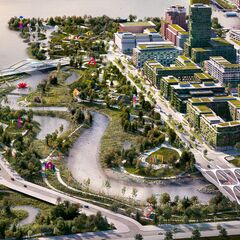steveintoronto
Superstar
It was far worse than that even. In their later life, they were part of a 'fly-by-night' operation to turn solvents and used oil sludge into engine fuel (ostensibly a diesel analog) and the MoE was there chronically to address the frequent 'spills' (where pipes and tanks had ruptured, and banned substances were found in the effluent) and cases of other companies (one with "Kleen" in their name) actually burying waste on-site. (They were prosecuted and the company found guilty on multiple counts, but the individuals responsible, IIRC, got off with being slapped with a greasy rag).It wasn't all that long ago that there were extensive petrochemical storage works right at Commissioner and Cherry, too.
Miraculously, the prior soil sample readings that deemed the area too toxic to excavate have themselves been laundered, and the reports purged.
Amazing what the laundering powers are when developers demand action on the soiled past. No problem! Just add the deep cleaning power of PR and renderings of pastoral beauty, and we'll all live happily in Nirvana ever after.
Someone's in for a hell of a shock when the reality of the clean-up actually hits.
Edit to Add: I see this one was too difficult to keep on the hush. The drivers kind of 'spilled the beans' in muted but careless banter at the then Knob Hills Farm restaurant. Some of the undercover Feds got wind of it (won't go any further on that one here) and it got back to their provincial counterparts, and the Province had to act:
http://www.waterfrontoronto.ca/nbe/...&CACHEID=82426b80-2794-48d1-9be1-bfb3b61fbdb2PORT LANDS ENVIRONMENTAL RESTORATION UPDATE
Temporary closure of Portions of the Martin Goodman Trail and the East Parking
Lot at Cherry Beach
The Toronto Waterfront Revitalization Corporation (TWRC) and the Toronto Economic
Development Corporation (TEDCO) are now undertaking environmental restoration work
in the area of Cherry Beach as part of an
overall environmental m
anagement strategy for
the Port Lands.
From April - May, 2007, portions of the Martin Goodman Trail, as well as the entire east
parking lot at Cherry Beach, will be closed so the environmental restoration work can
take place.
A temporary fence will be set up in the eastern portion of Cherry Beach, securing the
area south-west of the former Safety Kleen facility at 115 Unwin Avenue to Lake Ontario.
The work is necessary to remove contaminants that are floating on the groundwater.
Proven technologies are being used to address the contamination. This involves digging
trenches and installing a pumping system to pump the contaminated groundwater to a
treatment station on the former Safety
Kleen site where the contaminants will be
screened, filtered, and treated appropriately. The contaminated material will then be
securely shipped to a licensed treatment facility on a regular basis.
A remedial action plan outlining this work has been submitted to the Ontario Ministry of
the Environment (MOE) for review.
During this work period, there will be no access to the beach parking lot east of Cherry
Street and there will be limited access to the waterfront and a portion of the Martin
Goodman Trail (south of Unwin Avenue between Cherry Street and Regatta Road).
Visitors to the Port Lands during this time can refer to the alternate trail routes outlined in
the attached map and provided on the TWRC website (
www.towaterfront.ca
).
Safety Kleen site clean-up
Once the Martin Goodman Trail and east parking lot area is re-opened in May, TEDCO
will immediately start addressing the issues directly on the Safety Kleen site, using
similar technologies. The entire process is likely to take from five to 10 years to
complete.
For more information, please contact Toronto Waterfront Revitalization Corporation at
416-214-1344 or
info@towaterfront.ca
Nothing to see here folks! Please, move right along, everything is under control....
Last edited:























